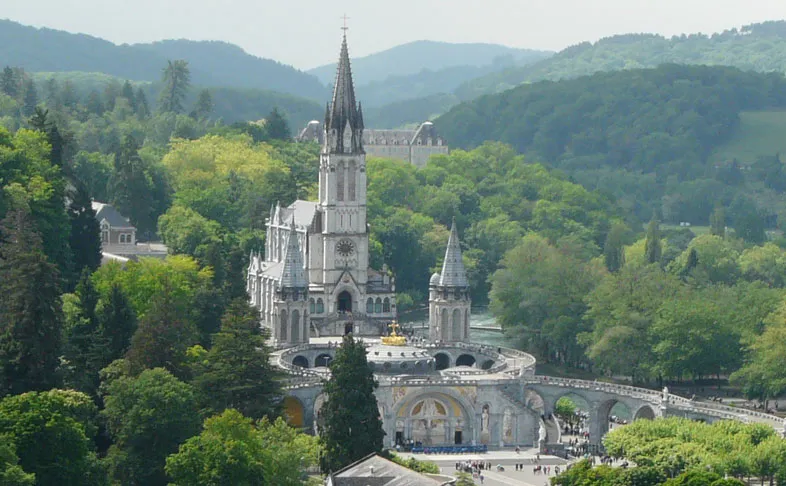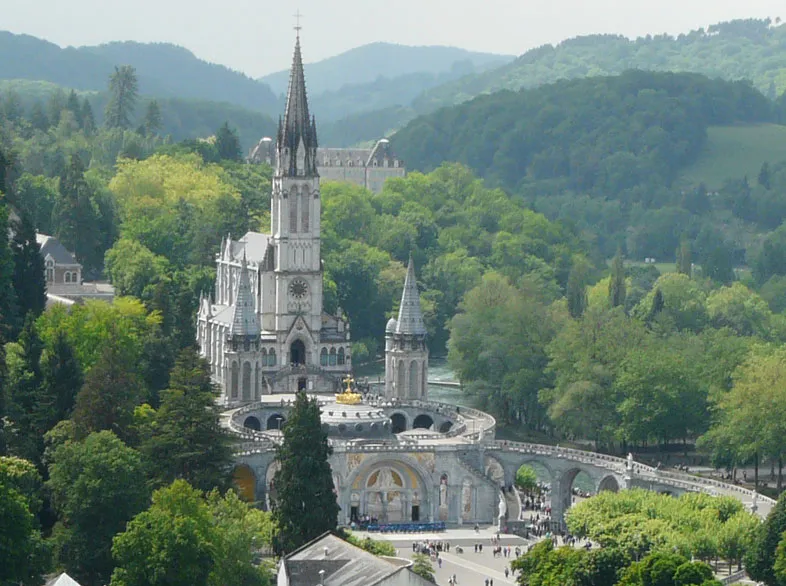
Introduction
The Sanctuary of Our Lady of Lourdes, France (French: Sanctuaire de Notre-Dame de Lourdes) or the Domain (as it is most commonly known) is an area of ground surrounding the Catholic shrine (Grotto) to Our Lady of Lourdes in the town of Lourdes, France. The Sanctuary is a destination for pilgrimage; sick pilgrims are reputed to be miraculously healed by Lourdes water.
This ground is owned and administered by the Roman Catholic Church, and has several functions, including devotional activities, offices, and accommodation for sick pilgrims and their helpers. The Domain includes the Grotto itself, the nearby taps which dispense the Lourdes water, and the offices of the Lourdes Medical Bureau, as well as several churches and basilicas. It comprises an area of 51 hectares, and includes 22 separate places of worship. There are six official languages of the Sanctuary: French, English, Italian, Spanish, Dutch and German.
Grottos intended as replicas of the one at Our Lady of Lourdes, and other grottos in honour of Our Lady of Lourdes, are often described as “Lourdes grottos”.
History of Sanctuary of Our Lady of Lourdes, France
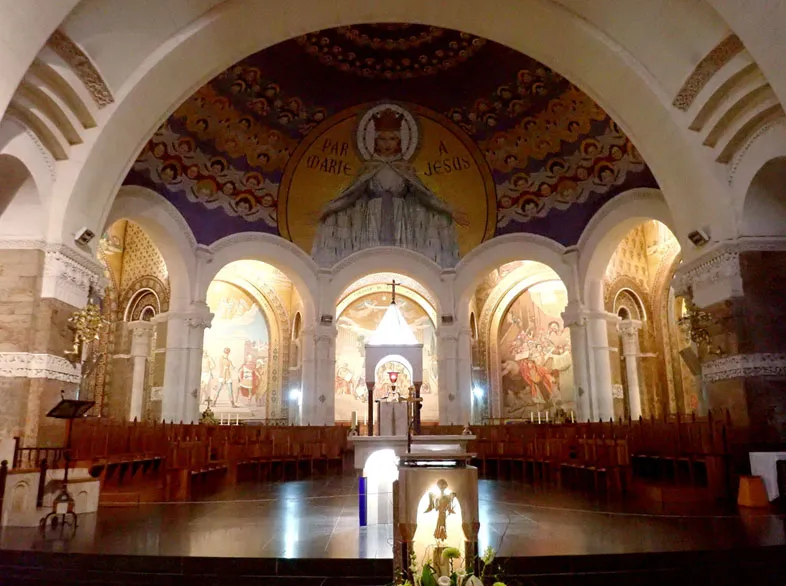
The Sanctuary of Our Lady of Lourdes, France, began in the 19th century AD. In 1858 from 11 February to 16 July, a 14-year-old peasant girl, called Bernadette Soubirous, saw a vision of the Virgin Mary while playing in the stream with her sister and friend. The vision was of Mary standing next to a rose bush at the entrance to the Massabielle grotto, on the left bank of the stream. Bernadette saw this vision 18 times.
She told her sister not to tell their parents, but her sister was bad at keeping secrets and told them anyway. Her parents became mad and forbid them to go to the grotto again. Bernadette ignored their orders. She was told by the Lady that a spring would appear there, and that people were to come in procession.
On land bordered by a loop of the Gave de Pau river is an outcrop of rock called Massabielle, (from masse vieille: “old mass”). On the northern aspect of this rock, near the river bank, is a naturally occurring, irregularly shaped shallow cave or grotto, in which the apparitions took place.
At the time of the apparitions, the grotto lay well outside town, on common ground which was used by the villagers variously for pasturing animals, collecting firewood, and as a garbage dump, and it had a reputation for being an unpleasant place.
The figure always appeared in one place, a niche above the main cavity of the grotto, in which a wild rose bush was growing. Among the instructions from ‘the Virgin’ were “Go and drink from the spring”, “Go and tell the priests to build a chapel here”, and “Have the people come here in procession”. These three instructions in particular were to prove pivotal in the development of the Domain and its ceremonies.
Public interest in the apparitions grew, and curious visitors began to be replaced by pilgrims from increasingly far away, drawn by compelling stories of apparitions and miracles.
A local priest, Abbé Dominique Peyramale, together with his bishop, Monsignor Bertrand-Sévère Mascarou Laurence, bought the grotto and the land around it from the commune in 1861, 3 years after the apparitions. Immediately they set about modifying the area to make it more accessible to visitors, and started work to build the first of the churches, which is now known as the Crypt.
In 1864, the Lyonnais sculptor Joseph-Hugues Fabisch was commissioned to create a statue of Our Lady of Lourdes based on Bernadette’s descriptions. Although it has become an iconic symbol of Our Lady of Lourdes, it depicts a figure which is not only older and taller than Bernadette’s description, but also more in keeping with orthodox and traditional representations of the Virgin Mary. The statue rests in the niche where the Virgin appeared to Bernadette. The original wild rose bush was destroyed shortly after the apparitions by pilgrims seeking relics, but a newer one has been planted nearby.
Due to French political upheaval resulting in an enforced separation of Church and State, the property and grounds of the Domain were confiscated from the Church and returned to the ownership of the town in 1910. The then bishop, Mgr. François-Xavier Schoepfer, contested this confiscation and was permitted to rent the Domain from the town until the outbreak of World War I in 1914.
Later, a visit to Lourdes by Marshal Pétain in 1941 provided official recognition of the Domain. Church officials successfully petitioned Pétain to allow the Church to reclaim ownership of the Domain.
Administration

The Sanctuary of Our Lady of Lourdes, France – The Bishop of Tarbes and Lourdes is responsible for the spiritual governance of the Domain. He appoints a local representative, who is called the Rector. The Domain is run independently of the parish of Lourdes, which is responsible for the spiritual needs of the Lourdais themselves.
Thirty full-time chaplains work in the Domain, from dioceses and religious communities worldwide. As of 2010 there were 292 full-time lay employees and a further 120 seasonal employees working in 63 different divisions, with an annual running budget of €18 million, 90% from donations.
The Domain is open all year round. In winter there are many fewer visitors, a reduced timetable of services and devotional activity, and no processions. The winter season runs from 1 November (the feast of All Saints) until Easter. On 11 February, the Feast of Our Lady of Lourdes, a full programme of activities usually takes place.
The Domain is fully active between Easter and All Saints each year, and has a programme of devotional activities including Mass, processions, Adoration of the Blessed Sacrament, and the Sacrament of Reconciliation. Many activities are carried out in several languages; in some services the liturgy is repeated in different languages.
The grounds are open daily from 5 am until midnight; outside these times the Grotto is accessible via the Lacets Gate behind the Upper Basilica.
An estimated 200 million people have visited the shrine since 1860. The Roman Catholic Church has officially recognized 70 miracle healings, the 70th of which was the cure of Sister Bernadette Moriau, recognised on 11 February 2018.
About 800 tonnes of wax is burnt annually in devotional candles.
The Domain publishes the monthly Lourdes News, with news and featured articles about the Domain and Lourdes generally.
Our Lady of Lourdes

Our Lady of Lourdes (French: Notre-Dame de Lourdes) is a title of Mary, mother of Jesus. The Virgin Mary is venerated under this title by the Roman Catholic church due to her apparitions that occurred in Lourdes, France. The first apparition of 11 February 1858, of which Bernadette Soubirous (age 14) told her mother that a “Lady” spoke to her in the cave of Massabielle (1.5 kilometres from the town) while she was gathering firewood with her sister and a friend.
Similar apparitions of the “Lady” were reported on 18 occasions that year, until the climax revelation of Our Lady of the Immaculate Conception took place. On 18 January 1862, the local Bishop of Tarbes Bertrand-Sévère Laurence endorsed the veneration of the Blessed Virgin Mary in Lourdes.
On 1 February 1876, Pope Pius IX officially granted a decree of canonical coronation to the image as Notre-Dame du Saint Rosaire. The coronation was performed by Cardinal Pier Francesco Meglia at the courtyard of what is now part of the Rosary Basilica on 3 July 1876.
The image of Our Lady of Lourdes has been widely copied and reproduced in shrines and homes, often in garden landscapes. Bernadette Soubirous was canonized by Pope Pius XI in 1933.
Marian devotion has since steadily increased as ecclesiastical investigations sanctioned her visions. In later years, a large church was built at the site that has since become a major site of religious pilgrimage.
Apparitions

On 11 February 1858, Soubirous went with her sister Toinette and neighbor Jeanne Abadie to collect some firewood. While taking off her shoes and stockings to wade through the water near the Grotto of Massabielle, she said she heard the sound of two gusts of wind (coups de vent) but the trees and bushes nearby did not move. A wild rose in a natural niche in the grotto, however, did move.
I came back towards the grotto and started taking off my stockings. I had hardly taken off the first stocking when I heard a sound like a gust of wind. Then I turned my head towards the meadow. I saw the trees quite still: I went on taking off my stockings. I heard the same sound again. As I raised my head to look at the grotto, I saw a lady dressed in white, wearing a white dress, a blue girdle and a yellow rose on each foot, the same color as the chain of her rosary; the beads of the rosary were white … From the niche, or rather the dark alcove behind it, came a dazzling light.
Soubirous tried to make the sign of the cross but could not, as her hands were trembling. The lady smiled, and invited Soubirous to pray the rosary with her. Soubirous tried to keep this a secret, but Toinette told her mother. After parental cross-examination, she and her sister received corporal punishment for their story.
Three days later, 14 February, Soubirous returned to the grotto. She had brought holy water as a test that the apparition was not of evil origin/provenance: “The second time was the following Sunday … Then I started to throw holy water in her direction, and at the same time I said that if she came from God she was to stay, but if not, she must go. She started to smile, and bowed … This was the second time.”
Soubirous’ companions are said to have become afraid when they saw her in ecstasy. She remained ecstatic even as they returned to the village. On 18 February, she spoke of being told by the Lady to return to the Grotto over a period of two weeks. She quoted the apparition: “The Lady only spoke to me the third time … She told me also that she did not promise to make me happy in this world, but in the next.”
Soubirous was ordered by her parents to never go there again. She went anyway, and on 24 February, Soubirous related that the apparition asked for prayer and penitence for the conversion of sinners.
The next day, she said the apparition asked her to dig in the ground and drink from the spring she found there. This made her dishevelled and some of her supporters were dismayed, but this act revealed the stream that soon became a focal point for pilgrimages. Although it was muddy at first, the stream became increasingly clean. As word spread, this water was given to medical patients of all kinds, and many reports of miraculous cures followed.
Seven of these cures were confirmed as lacking any medical explanations by Professor Verges in 1860. The first person with a “certified miracle” was a woman whose right hand had been deformed as a consequence of an accident. Several miracles turned out to be short-term improvement or even hoaxes, and Catholic Church and government officials became increasingly concerned.
The government fenced off the grotto and issued stiff penalties for anybody trying to get near the off-limits area. In the process, Lourdes became a national issue in France, resulting in the intervention of Emperor Napoleon III with an order to reopen the grotto on 4 October 1858. The church had decided to stay away from the controversy altogether.
Soubirous, knowing the local area well, managed to visit the barricaded grotto under cover of darkness. There, on 25 March, she said she was told: “I am the Immaculate Conception” (“que soy era immaculada concepciou”). On Easter Sunday, 7 April, her examining doctor stated that Soubirous, in ecstasy, was observed to have held her hands over a lit candle without sustaining harm. On 16 July, Soubirous went for the last time to the grotto. “I have never seen her so beautiful before,” she reported.
The Catholic Church, faced with nationwide questions, decided to institute an investigative commission on 17 November 1858. On 18 January 1860, the local bishop finally declared that: “The Virgin Mary did appear indeed to Bernadette Soubirous.” These events established the Marian veneration in Lourdes, which together with Fátima and the Basilica of Our Lady of Guadalupe is one of the most frequented Marian shrines in the world, and to which between 4 and 6 million pilgrims travel annually.
In 1863, Joseph-Hugues Fabisch was charged to create a statue of the Virgin according to Soubirous’s description. The work was placed in the grotto and solemnly dedicated on 4 April 1864 in presence of 20,000 pilgrims.
The veracity of the apparitions of Lourdes is not an article of faith for Catholics. Nevertheless, all recent popes have visited the Marian shrine at some time. Benedict XV, Pius XI, and John XXIII went there as bishops, Pius XII as papal delegate. He also issued an encyclical, Le pèlerinage de Lourdes, on the one-hundredth anniversary of the apparitions in 1958. John Paul II visited Lourdes three times during his pontificate, and twice before as a bishop.
Bernadette's Description of Mary

Soubirous described the apparition as uo petito damizelo (“a tiny maiden”) of about 14-15 years old; Soubirous insisted that the apparition was no taller than herself. At 1.40 metres (4 ft 7 in) tall, Soubirous was diminutive even by the standards of other poorly-nourished children.
Soubirous described the apparition as dressed in a flowing white robe, with a blue sash around her waist. This was the uniform of a religious group called the Children of Mary, which, on account of her poverty, Soubirous was not permitted to join (although she was admitted after the apparitions). Her aunt Bernarde was a long-time member.
The statue that currently stands in the niche within the grotto of Massabielle was created by the Lyonnais sculptor Joseph-Hugues Fabisch in 1864. Although it has become an iconographic symbol of Our Lady of Lourdes, it depicts a figure which is not only older and taller than Soubirous’ description, but also more in keeping with orthodox and traditional representations of the Virgin Mary. On seeing the statue, Soubirous was profoundly disappointed with this representation of her vision.
Similar Events
In nearby Lestelle-Bétharram, only a few kilometres from Lourdes, some shepherds guarding their flocks in the mountains observed a vision of a ray of light that guided them to the discovery of a statue of the Virgin Mary. Two attempts were made to remove the statue to a more prominent position; each time it disappeared and returned to its original location, at which a small chapel was built for it.
In the early 16th century, a 12-year-old shepherdess called Anglèze de Sagazan received a vision of the Virgin Mary near the spring at Garaison (part of the commune of Monléon-Magnoac), somewhat further away. Anglèze’s story is strikingly similar to that of Soubirous: she was a pious but illiterate and poorly educated girl, extremely impoverished, who spoke only in the local language, Gascon Occitan, but successfully convinced authorities that her vision was genuine and persuaded them to obey the instructions of her apparitions.
Like Soubirous, she was the only one who could see the apparition; however, the apparition at Garaison’s supernatural powers tended toward the miraculous provision of abundant food, rather than healing the sick and injured. Mid-nineteenth century commentators noted the parallels between the events at Massabielle and Garaison, and interpreted the similarities as proof of the divine nature of Soubirous’ claims. At the time of Soubirous, Garaison was a noted center of pilgrimage and Marian devotion.
There are also several similarities between the apparition at La Salette, near Grenoble, and Lourdes. La Salette is many hundreds of kilometres from Lourdes, and the events at La Salette predate those in Lourdes by 12 years. However, the Marian apparition at La Salette was tall and maternal (not petite and gentle like her Lourdes apparition) and had a darker, more threatening series of messages. It is not certain if Soubirous was aware of the events at La Salette.
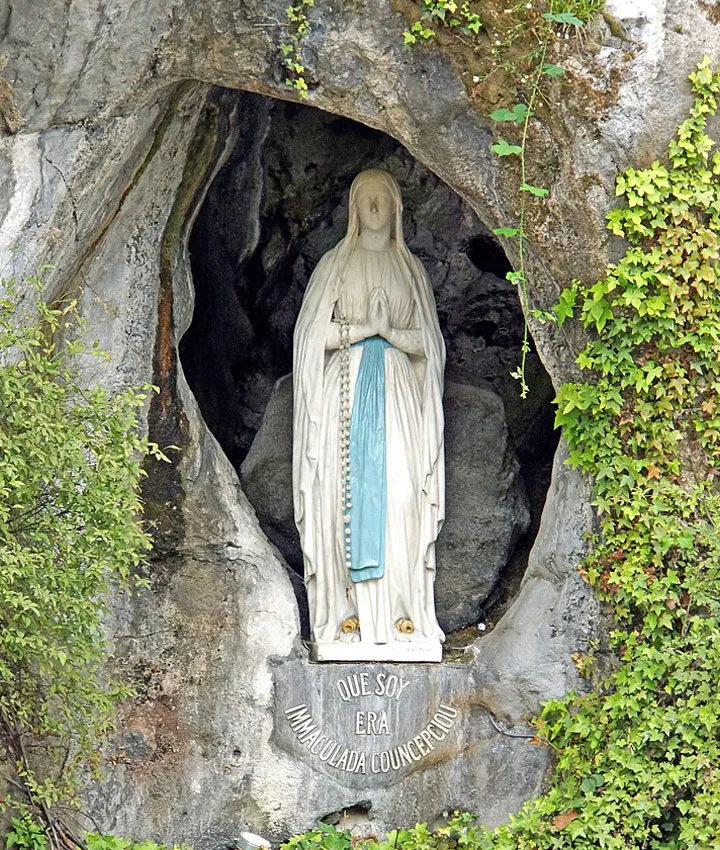
Approval by a Local Bishop
On 18 January 1862, the Bishop of Tarbes Betrand Severt Laurence declared the following regarding the Marian apparitions:
“We are inspired by the Commission comprising wise, holy, learned and experienced priests who questioned the child, studied the facts, examined everything and weighed all the evidence. We have also called on science, and we remain convinced that the Apparitions are supernatural and divine, and that by consequence, what Soubirous saw was the Most Blessed Virgin. Our convictions are based on the testimony of Soubirous, but above all on the things that have happened, things which can be nothing other than divine intervention.”
Reported Healings
The Sanctuary of Our Lady of Lourdes, France – The location of the spring was described to Soubirous by an apparition of Our Lady of Lourdes on 25 February 1858. Since that time many thousands of pilgrims to Lourdes have followed the instruction of Our Lady of Lourdes to “drink at the spring and wash in it”.
Lourdes water has become a focus of devotion to the Virgin Mary at Lourdes. The Catholic Church has formally endorsed, although not dogmatic, for sick people to bathe and visit Lourdes for healing. Since the apparitions, many people have claimed to have been cured by drinking or bathing in it, and the Lourdes authorities provide it free of charge to any who ask for it.
An analysis of the water was commissioned by then mayor of Lourdes, Monsieur Anselme Lacadé in 1858. It was conducted by a professor in Toulouse, who determined that the water was potable and that it contained the following: oxygen, nitrogen, carbonic acid, carbonates of lime and magnesia, a trace of carbonate of iron, an alkaline carbonate or silicate, chlorides of potassium and sodium, traces of sulphates of potassium and soda, traces of ammonia, and traces of iodine. Essentially, the water is pure and inert.
Lacadé had hoped that Lourdes water might have special mineral properties which would allow him to develop Lourdes into a spa town, to compete with neighbouring Cauterets and Bagnères-de-Bigorre.
The Lourdes Medical Bureau
To ensure claims of cures were examined properly and to protect the town from fraudulent claims of miracles, the Lourdes Medical Bureau (Bureau Medical) was established at the request of Pope Pius X. It is completely under medical rather than ecclesiastical supervision. Approximately 7,500 people have sought to have their case confirmed as a miracle, of which 70 have been declared scientifically inexplicable by the bureau.

Lourdes Water
Lourdes water flows from a spring at the same spot where it was discovered by Bernadette. The original spring can be seen within the Grotto, lit from below and protected by a glass screen. Pilgrims drink Lourdes water due to its reputed healing power. The water is accessed from individual taps located between the grotto and the baths.
The water from Lourdes was thoroughly analysed by independent chemists in 1858 and 1859, and does not appear to have a latent power to cure and has no special scientific or medicinal properties. Despite this, the water is itself a strong symbol of devotion for Lourdes pilgrims, and many buy statues and rosary beads containing small vials of it, and take home large plastic containers of it.
Baths
Each year about 350,000 pilgrims bathe in the water at the baths (Piscines). During the pilgrimage season, the baths are open 8:30 am –12:30 pm / 1:30 – 6:00 pm on weekdays and 10.00 am-12.00 noon / 2.00 pm-4.00 pm Sundays and Holidays.
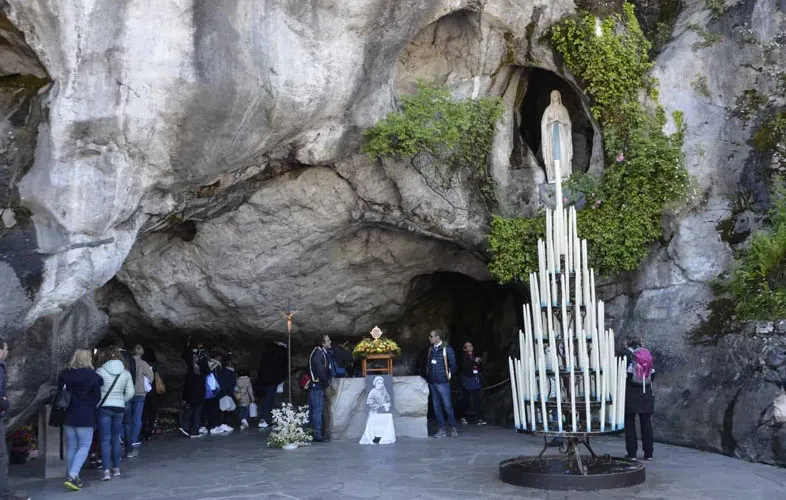
Blessed Sacrament Procession
The Blessed Sacrament procession is held daily at 5:00 pm. The procession begins at the open-air altar on the prairie across the river from the grotto and is led by sick pilgrims followed by a priest, bishop or cardinal carrying a monstrance containing the Blessed Sacrament. Typically the bearer of the Blessed Sacrament is sheltered from the elements by a mobile awning/canopy, called a baldachin, carried by four assistants.
The Blessed Sacrament is accompanied by bearers carrying candles, incense burners or other devotional symbols. These bearers are lay helpers chosen from the pilgrims. Following directly behind the Blessed Sacrament, both during the procession and the Blessing of the Sick, will be a representative group of doctors from the various pilgrimages. Lastly, there are groups of pilgrims, some following their parish or diocesan banner.
The procession makes its way across the river, past the Crowned Statue, along the esplanade and down into the St. Pius X underground basilica where the sick pilgrims are placed at the front of the altar. During the procession there are meditations, prayers, hymns and chants, in several languages. When all the participants have assembled, there is a period of Eucharistic Adoration, followed by the Blessing of the Sick.
During extreme weather conditions, the procession will take place inside the basilica.
Torchlight Procession
The Torchlight Marian Procession takes place daily at 9.00pm. It begins near the Grotto and continues around the esplanade ending in the Rosary square. In extreme weather an indoor ceremony may be held in the Underground Basilica instead. The procession is led by sick pilgrims followed by volunteers carrying a replica of the Cabuchet Statue of the Virgin Mary. Most participants carry a candle.
The focus of this procession is the rosary. All five decades are recited, usually in a variety of languages. The Lourdes Hymn is also sung, with verses in different languages. Intercessions may be invoked followed by the Laudate Mariam. There is a final blessing in Latin, and then an invitation to exchange the Sign of peace with fellow pilgrims.
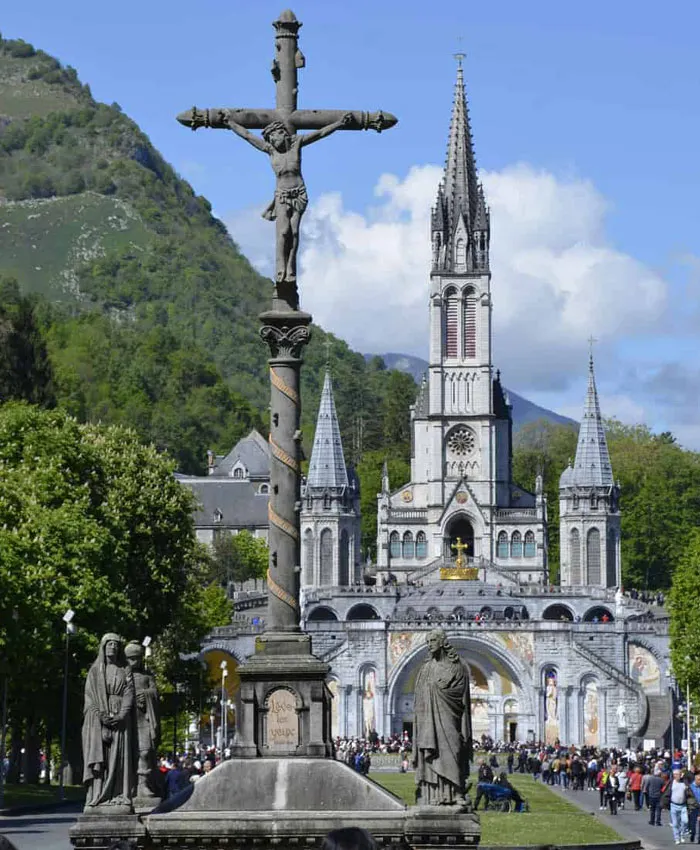
Crypt
The Crypt was the first of the churches to be completed in the Domain, and is today among the smallest. Construction was started by Abbé Peyramale and Mgr. Laurence. Bernadette’s father worked on its construction and was present at its official opening, on Pentecost Sunday, 1866.
The nave is small and a notable feature as are the enormous pillars which support the weight of the Upper Basilica, which was constructed on top of it.
The Crypt is entered along a corridor, whose entrance is dominated by a large bronze statue of St. Peter, holding the Keys of the Kingdom of Heaven. Opposite stands a statue of Pius X. The walls of the corridor and nave are lined with small marble plaques, known as ex voto plaques, donated in thanks of spiritual favours received.
Upper Basilica
The Basilica of the Immaculate Conception, known widely as the Upper Basilica, was the second of the churches to be completed, consecrated in 1876. It is an impressive, elaborate building in Gothic style, designed by architect Hyppolyte Durand, and on one side seems to emerge directly from the rock of Massabielle (the sanctuary is directly above the Grotto). The walls are lined with ex voto plaques, and banners from official National Pilgrimages of the past. It has a series of stained-glass windows depicting various events in the story of Lourdes; the clerestory windows depict Mary as the Second Eve.
The exterior is dominated by a 70m spire, and two lesser spires (not completed until 1908). Above the entrance is a mosaic depicting Pope Pius IX, who defined the dogma of the Immaculate Conception in 1854.
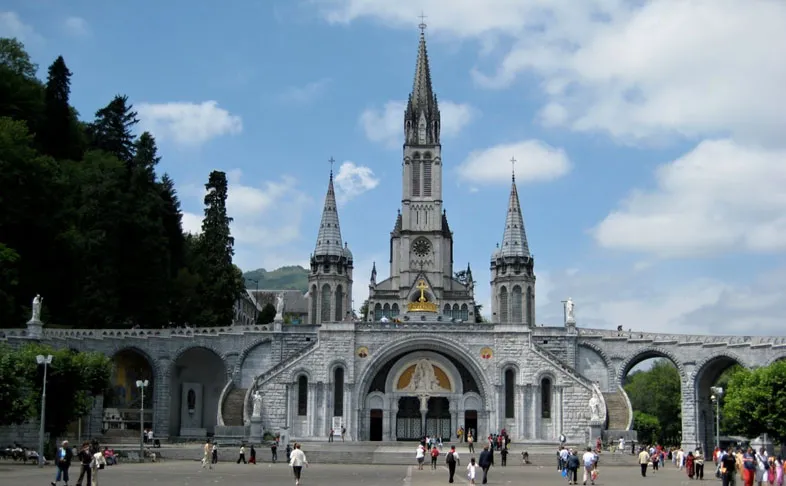
Rosary Basilica
The Rosary Basilica is the third of the churches to be completed, in 1899, and designed by architect Leopold Hardy. It was consecrated in 1901 and has a capacity of 1,500 worshipers. Its style is influenced by Byzantine architecture. The nave is open and circular, surmounted by a dome. The exterior of the dome is surmounted by a dramatic gilded crown and cross, which were a gift from the people of Ireland in 1924.
The exterior facade of the basilica was modified in 2007 to include a depiction of the Luminous Mysteries, which are not a part of traditional fifteen, but of an extended version of it by Pope John Paul II in 2002.
Crowned Statue and Rosary Square
The open space in front of the Rosary Basilica is known as Rosary Square.
The entrances to the Crypt and the Upper Basilica, both of which are built on top of Massabielle, are far above ground level. To facilitate access, two enormous ramps were constructed, which curve down either side of Rosary Square. The image of the entrance of the Rosary Basilica, flanked by the two ramps and surmounted by the spires of the Upper Basilica, has become one of the iconic symbols of Lourdes, and a stylised form of this image has been adopted by the Domain itself as its logo.
The Statue of the Crowned Virgin, often known as the “Crowned Statue” (French: La Vierge Couronnée), stands across Rosary Square from the Rosary Basilica and faces the entrance. This prominent statue is a familiar landmark and a traditional meeting point. The statue is 2.5 m high and cast in bronze, painted white and blue in the traditional colours. Her rosary is of the Birgittine style and incorporates six decades.
Behind the Crowned Statue is the Esplanade, a large open walk away which is used for the processions.
Underground Basilica
The Basilica of St. Pius X, known as the Underground Basilica, is the largest and most controversial of the Domain’s churches. It was designed by the architect Pierre Vago and completed in 1958 in anticipation of the enormous crowds expected in Lourdes for the centenary of the Apparitions. A modern, concrete building, it is almost entirely underground (part of the building lies beneath the Boulevard Père Rémi Sempé above). When full it can accommodate 25,000 worshippers.
Feast Day - 11th February
The liturgical feast of Our Lady of Lourdes was established for 11th February, approved by Pope Leo XIII, and first granted to the Diocese of Tarbes in the year 1890. Less than twenty years later, on November 13, 1907, his successor, Pope St. Pius X proclaimed that it be observed throughout the universal Church.
Mass Time
Every Days
Church Visiting Time
Contact Info
1 Avenue Mgr Théas,
65108 Lourdes, France.
Phone No.
Tel : +33 5 62 42 78 78
Accommodation
How to reach the Sanctuary
Tarbes–Lourdes–Pyrénées Airport (Tarbes (LDE) Airport) in southwest of Tarbes in the Hautes-Pyrénées département of France is the nearby Airport to the Sanctuary.
The Gare de Lourdes Railway Station in Lourdes, Occitanie, France is the nearby Train Station to the Sanctuary.

